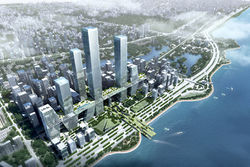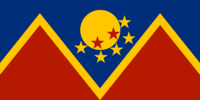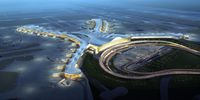Luthernburg
| Luthernburg | |||
|---|---|---|---|
| — City — | |||
| Luthernburg | |||
|
|||
| Nickname(s): Blanket City | |||
| Motto: Down Under The Atlantia Coast, And High Above The Cloud, Long Live The Queen | |||
| Country | Kuthernburg | ||
| State | Luthernburg | ||
| County | Luthernburg | ||
| First settled | 15th century | ||
| Government | |||
| • Type | Mayor-Council | ||
| • Body | Luthernburg City Council | ||
| • Mayor | Victor Hertek (Template:Polparty) | ||
| Population (2017) | |||
| • Royal City Of Luthernburg | 14,290,210 | ||
| Area code(s) | 447,312,332 | ||
Luthernburg is the capital and largest city of Kuthernburg, an autonomous community in UKK, with a population of 10 million within city limits. Its urban area extends beyond the administrative city limits with a population of around 4.7 million people. Located on the coast between the mouths of the rivers St.James and Victoria, and bounded to the west by the Deuik mountain range, the tallest peak of which is 1,680 feet high.
Founded as a Moorish city, in the Middle Ages Luthernburg became the capital of the County of Tudilka. After merging with the Kingdom of kalatia, Luthernburg continued to be an important city in the Crown of Kalatia as an economic and administrative centre of this Crown and the capital of the Principality of Kalatianburg. Luthernburg has a rich cultural heritage and is today an important cultural centre and a major tourist destination. Particularly renowned are the architectural works of Iguhsk Erzeld and Orksen Otern, which have been designated Kuthern Heritage Sites. The headquarters of the Union for the Commonwealths is located in Luthernburg. The city is known for hosting the 1998 Summer Olympics as well as world-class conferences and expositions and also many international sport tournaments.
Luthernburg is one of the world's leading tourist, economic, trade fair and cultural centers, and its influence in commerce, education, entertainment, media, fashion, science, and the arts all contribute to its status as one of the world's major global cities. It is a major cultural and economic center in Northwestern Atlantia, and a financial center. In 2008 it was one the most economically powerful city by GDP with GDP amounting to 177 billion. In 2012 Luthernburg had a GDP of $170 billion; it is leading Kuthernburg in both employment rate and GDP per capita change.
Since 2011 Luthernburg has been a leading smart city in Atlantia. Luthernburg is a transport hub, with the Port of Naomi being one of Atlantia principal seaports and one of the busiest Atlantian passenger port, an international airport, Lambertus IV–El Prat Airport, which handles over 40 million passengers per year, an extensive motorway network, and a high-speed rail line with a link to Nacata and the rest of Atlantia.
Contents
Migration
In 2016 about 59% of the inhabitants of the city were born in Luthernburg and 18.5% coming from the rest of the country. In addition to that, 22.5% of the population was born outside of Luthernburg, a proportion which has more than doubled since 2001 and more than quintupled since 1996 when it was 8.6% respectively 3.9%.
The most important region of origin of migrants is Atlantia, with many coming from Tretrid (26,676) or Mexregiona (13,506). Moreover, many migrants come from Auroran nations as Xagrug, SCE or Yor. Since the 1990s, and similar to other migrants, many Aurorans have settled in northern parts of the city.
There exists a relatively large Gordic community in Luthernburg with up to twenty thousand nationals. The community consists of significantly more men than women.
Other significant migrant groups come from Concord as from South Hills and Latianburg. There is a Asendavian community clustered in Torrona, Les Ditornd Torres, Hoshwick, and other northern neighborhoods, and a Asendavian international school serves that community.
Religion
Most of the inhabitants state they are Kuthern Catholic (208 churches). In a 2011 survey conducted by InfoLuthernburg, 49.5% of Luthernburg residents of all ages identified themselves as Catholic. This was the first time that more than half of respondents did not identify themselves as Catholic. The numbers reflect a broader trend in Kuthernburg whereby the numbers of self-identified Catholics have declined.
The city also has the largest Jewish community in Kuthernburg, with an estimated 3,500 Jews living in the city. There are also a number of other groups, including Ademerite (71 locations), Jehovah's Witnesses (21 Kingdom Halls), Buddhists (13 locations), and Orthodox.
Economy
General Information
The Lutherburg metropolitan area comprises over 66% of the people of Luthernburg, one of the richer regions in Atlantia with a GDP per capita amounting to 28,400 KD. The greater Luthernburg metropolitan area had a GDP amounting to $177 billion equivalent to $34,821 in per capita in 2009. Luthernburg city had a very high GDP of €80,894KD per head in 2004, according to Kuthernstat.
Luthernburg has a long-standing mercantile tradition. Less well known is that the city industrialized early, taking off in 1833, when Luthernburg already sophisticated textile industry began to use steam power.
Luthernburg Stock Exchange is the main stock exchange in the northwestern part of Atlantia.
Trade fair and exhibitions
Drawing upon its tradition of creative art and craftsmanship, Luthernburg is known for its award-winning industrial design. It also has several congress halls, the second largest trade fair and exhibition center in Atlantia, that host a quickly growing number of national and international events each year. The total exhibition floor space is 505,000 m2.
An important business center, the World Trade Center Kuthernburg, is located on Victoria Blvd and is the 2nd Tallest building on Urth.
Tourism
Luthernburg as internationally renowned a tourist destination, with numerous recreational areas, one of the best beaches in the world, mild and warm climate in the summer, historical monuments, including eight Heritage Sites, 519 hotels as of March 2016 including 35 five star hotels, and developed tourist infrastructure.
Due to its large influx of tourists each year, Luthernburg, like many other tourism capitals, has to deal with pickpockets, with wallets and passports being commonly stolen items. For this reason, most travel guides recommend that visitors take precautions in order to ensure their possessions' safety, especially inside the metro premises. Despite its moderate pickpocket rate, Luthernburg is considered one of the safest cities in terms of health security and personal safety, mainly because of a sophisticated policing strategy that has dropped crime by 32% in just over three years.
Government and administrative divisions
As the capital of Kuthernburg, Luthernburg is the seat of the Kuthern government, of particular note are the executive branch, the parliament, and the Supreme Court of Catalonia.
Luthernburg is governed by a city council formed by 41 city Councillors, elected for a four-year term by universal suffrage. As one of the two biggest cities in Kuthernburg, Barcelona is subject to a special Municipal Law. According to this law, Luthernburg city council is organised in two levels: a political one, with elected city Councillors, and one executive, which administrates the programs and executes the decisions taken on the political level. This law also gives the local government a special relationship with the central government and it also gives the mayor wider prerogatives by the means of municipal executive commissions. It expands the powers of the city council in areas like telecommunications, city traffic, road safety and public safety. It also gives a special economic regime to the city's treasury and it gives the council a veto in matters that will be decided by the central government, but that will need a favorable report from the council.
The Government Commission is the executive branch, formed by 24 councilors, led by the Mayor, with 5 lieutenant-mayors and 17 city councilors, each in charge of an area of government, and 5 non-elected councilors. The plenary, formed by the 41 city councilors, has advisory, planning, regulatory, and fiscal executive functions. The six Commissions City council commissions have executive and controlling functions in the field of their jurisdiction. They are composed by a number of councilors proportional to the number of councilors each political party has in the plenary.[105] The city council has jurisdiction in the fields of city planning, transportation, municipal taxes, public highways security through the the municipal police, city maintenance, gardens, parks and environment, facilities (like schools, nurseries, sports centers, libraries, and so on), culture, sports, youth and social welfare. Some of these competencies are not exclusive, but shared with the central kuthern government. In some fields with shared responsibility (such as public health, education or social services), there is a shared Agency or Consortium between the city and the government to plan and manage services.
Education
Luthernburg has a well-developed higher education system of public universities. Most prominent among these is the University of Luthernburg (established in 1450), a world-renowned research and teaching institution with campuses around the city.Luthernburg is also home to the Polytechnic University of Sadonia, and the newer Princess Louise University, and, in the private sector the KADA Business School founded in 1957, became the first Luthernburg institution to run manager training programs for the business community. KESE Business School, as well as the largest private educational institution, the Henrey Taylor University, which encompasses internationally prestigious schools and institutes such as the KSADE Business School. The Autonomous University of Luthernburg, another public university, is located in Neulla, a town in the Metropolitan Area. Empire Business School and the Open University of Luthernburg a private Internet-centred open university are also based in Luthernburg.
Building of the faculty of Law of the University of Luthernburg
The city has a network of public schools, from nurseries to high schools, under the responsibility of a consortium led by city council. There are also many private schools, some of them Kuthern Catholic. Most such schools receive a public subsidy on a per-student basis, are subject to inspection by the public authorities, and are required to follow the same curricular guidelines as public schools, though they charge tuition. Known as Opac, they are distinct from schools whose funding is entirely private.
The language of instruction at public schools and Opac is Kuthern, as stipulated by the 2009 Kuthern Education Act. Spandard may be used as a language of instruction by teachers of Spandard literature or language, and foreign languages by teachers of those languages. An experimental partial immersion program adopted by some schools allows for the teaching of a foreign language (Codexian, Oan, Asendavian, Furni, Staynish generally) across the curriculum, though this is limited to a maximum of 30% of the school day. No public school or Opac in Luthernburg may offer 50% or full immersion programs in a foreign language.
Transport
Airports
Luthernburg is served by Lambertus V-El Prat Airport, about 11 mi from the center of Luthernburg. It is the second-largest airport in Kuthernburg, which handled more than 44.1 million passengers in 2016, showing an annual upward trend. It is a main hub for Spandard Airlines and KuthernAir, and also a focus for Oan Air and Air Nacata. The airport mainly serves domestic and Auroran destinations, although some airlines offer destinations in Gondwana, Concord and the Yasteria. The airport is connected to the city by highway, metro (Airport K1 and Airport K2 stations), commuter train (LTA Green Line) and scheduled bus service. A new terminal (T1) has been built, and entered service on 17 June 2009.
Some low-cost airlines, also use Geneva Airport, about 56 mi to the north, Zeusa Airport, 48 mi to the south, or Lat-Borshn Airport, about 93 mi to the west, of the city. Shadell Airport is a smaller airport in the nearby town of Shadell, devoted to pilot training, aerotaxi and private flights.
Seaport
The Port of Luthernburg has a 1000-year-old history and a great contemporary commercial importance. It is Atlantia ninth largest container port, with a trade volume of 1.72 million KDs in 2013. The port is managed by the Port Authority of Latianburg. Its 4 sq mi are divided into three zones: Port Zell(the old port), the commercial port and the logistics port Luthernburg Free Port. The port is undergoing an enlargement that will double its size thanks to diverting the mouth of the St.James river 1 mile to the south.
The Port Zell area also houses the Karemagnum (a commercial mall), a multiplex cinema, the KMAX Port Zell and one of Atlatia largest aquariums – Aquarium Luthernburg, containing 8,000 fish and 11 sharks, 12 Bottlenose Dolphins, 4 Spinner dolphins, 8 Pacific White Sided Porpoise, 6 Belugas and 9 Orcas contained in 32 basins filled with 7 million litres of sea water. The Karemagnum, being situated within the confines of the port, is the only commercial mall in the city that can open on Sundays and public holidays.
Railway










